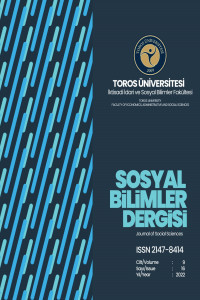AIS VE TİCARET VERİLERİ KULLANILARAK SERA GAZI EMİSYONU VE EĞİLİM TAHMİNİ
otomatik tanımlama sistemi, gemi emisyonu, sera gazları, LNG, Japonya
GREENHOUSE GAS EMISSION AND THEIR TREND PREDICTION USING AIS AND TRADE DATA
automatic identification system, ship emission, greenhouse gases, LNG, Japan.,
___
- Benamara, H., Hoffmann, J. and Youssef, F. (2019). Maritime Transport: The Sustainability Imperative. Psaraftis, H. N. (Ed.). in: Sustainable Shipping A Cross-Disciplinary View, Springer Nature Switzerland AG, pp. 1-31.
- Bereta, K., Chatzikokolakis, K. and Zissis, D. (2021). Maritime Reporting Systems. Artikis, A. and Zissis, D. (Ed.). in: Guide to Maritime Informatics, Springer Nature Switzerland AG, pp. 3-30.
- Cerdeiro, Komaromi, Liu and Saeed. (2020). AIS Data Collected by MarineTraffic. available at UN COMTRADE Monitor https://comtrade.un.org/data/ais (accessed 07 September 2022).
- Goldsworthy, B. (2017). Spatial and Temporal Allocation of Ship Exhaust Emissions in Australian Coastal Waters using AIS Data: Analysis and Treatment of Data Gaps. Atmospheric Environment, 163, 77-86.
- Harvald, S.A. (1983). Resistance and Propulsion of Ships. John Wiley & Sons.
- Holtrop, J. (1984). A Statistical Re-Analysis of Resistance and Propulsion Data. International Shipbuilding Progress, 31, 363.
- Holtrop, J. and Mennen, G.G.J. (1982). An Approximate Power Prediction Method. International Shipbuilding Progress, 29, 335.
- International Energy Agency. (2017). Energy efficiency 2017. Paris: IEA. available at: https://www.iea.org/reports/energy-efficiency-2017 (accessed 20 September 2022).
- International Energy Agency. (2019). LNG Market Trends and Their Implications. Paris: IEA. available at: https://www.iea.org/reports/lng-market-trends-and-their-implications (accessed 20 September 2022).
- International Gas Union. (2021). World LNG Report 2021. available at: https://www.igu.org/resources/world-lng-report-2021/ (accessed 15 September 2022).
- International Maritime Organization. (2014). Third IMO GHG Study 2014. London: International Maritime Organization.
- International Maritime Organization. (2021). Fourth IMO GHG Study. London: International Maritime Organization.
- International Towing Tank Conference. (2017). ITTC–Recommended Procedures and Guidelines; Procedure 7.5-02-02-01, Revision 04. Zurich: ITTC Association.
- Kim, H., Watanabe, D., Toriumi, S., and Hirata, E. (2021). Spatial Analysis of an Emission Inventory from Liquefied Natural Gas Fleet Based on Automatic Identification System Database. Sustainability. 13. 1250.
- Kristensen, H.O. and Lützen, M. (2013). Prediction of Resistance and Propulsion Power of Ships, Project no. 2010-56, Emissionsbeslutningsstøttesystem, Work Package 2, Report no. 04.
- Li, C., Yuan, Z., Ou, J., Fan, X., Ye, S., Xiao, T., Shi, Y., Huang, Z., Ng, S K.W., Zhong, Z. and Zheng, J. (2016). An AIS-Based High-Resolution Ship Emission Inventory and Its Uncertainty in Pearl River Delta Region, China. Science of the Total Environment, 573. 1-10.
- Man Diesel & Turbo. (2011). Basic Principles of Ship Propulsion. Denmark: MAN Diesel & Turbo).
- Ministry of Economy, Trade and Industry. Mineral Resources and Petroleum Products Statistics. available at: https://www.meti.go.jp/statistics/tyo/sekiyuka/ (accessed 07 September 2022).
- Ministry of Land, Infrastructure, Transport and Tourism. (2020). Roadmap to Zero Emission from International Shipping, Shipping Zero Emission Project.
- Molland, A.F., Hudson, D.A. and Turnock, S.R. (2017). Ship Resistance and Propulsion Practical Estimation of Ship Propulsive Power. Cambridge: Cambridge University Press.
- Munim, Z.H., Dushenko, M., Jimenez, V.J., Shakil, M.H. and Imset, M. (2020). Big Data and Artificial Intelligence in the Maritime Industry: A Bibliometric Review and Future Research Directions. Maritime Policy & Management. 47(5). 577-597.
- Nayar, K.G., Sharqawy, M.H. and Lienhard, J.H. (2016). Seawater Themophysical Properties Library. available at: http://web.mit.edu/seawater/2017_MIT_Seawater_Property_Tables_r2b.pdf (accessed 07 September 2022).
- United Nations Conference on Trade and Development. (2021). Review of Maritime Transport 2021. New York: United Nations Publications.
- United Nations. The United Nations Conference on the Law of the Sea 1982. available at: https://www.unclos.org/ (accessed 07 September 2022).
- Wang, Y., Watanabe, D., Hirata, E. and Toriumi, S. (2021). Real-Time Management of Vessel Carbon Dioxide Emissions Based on Automatic Identification System Database Using Deep Learning. Journal of Marine Science and Technology. 9. 871.
- Woo, D. and Im, N. (2021). Spatial Analysis of the Ship Gas Emission Inventory in the Port of Busan Using Bottom-Up Approach Based on AIS Data. Journal of Marine Science and Engineering. 9/ 1457.
- Yao, X., Mou, J., Chen, P. and Zhang, X. (2016). Ship Emission Inventories in Estuary of the Yangtze River Using Terrestrial AIS Data. TransNav the International Journal of Marine Navigation and Safety of Sea Transportation. 10. 633-640.
- ISSN: 2147-8414
- Yayın Aralığı: Yılda 2 Sayı
- Yayıncı: Toros Üniversitesi
LOJİSTİK SEKTÖRÜNDE PERSONEL SEÇİMİ İÇİN ÇOK KRİTERLİ KARAR VERME TEKNİĞİ YAKLAŞIMI: PSI ÖRNEĞİ
ÜÇ BOYUTLU AĞIRLIK MERKEZİ TESPİTİNE DAYALI MAKSİMUM YANAL KUVVETLE DEVRİLME ÖNLEME
Türkiye'de Kamyon Müfrezesi için Müfreze Oluşturma Merkezi Konumunun Optimizasyonu
COVID-19 Pandemisi Sırasında Atmosferik Etkiler Üzerine Bir Analiz: Bir Ro-Ro Limanı Örneği
Zeynep ERDOĞAN, İsmail Çağrı KILIÇ, Yasin AFŞAR, Arzum BÜYÜKKEKLİK
Sürdürülebilir Ulaşım İle Lojistik Merkez Yer Seçimi
Burçin PAÇACI, Serpil EROL, Kürşat ÇUBUK
Experienced Problems with Online Shopping: The Case of Turkey
Blockchain Teknolojisi ve Sürdürülebilir Lojistik: Döngüsel Ekonomi Entegrasyonu
